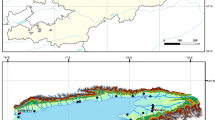Abstract
The paper presents data on the possibility of using the proportions of concentrations of polycyclic aromatic hydrocarbons (PAH) as indicators of the pollution sources with oil hydrocarbons. Approaches are suggested to estimate the efficiency of these indicator ratios, and the efficiency of the currently used ratios is evaluated. Multivariate data analysis is applied to demonstrate how the ratios depend on the degree of transformation of the petroleum products. The data presented in the paper are utilized to more accurately determine the indicator ratios of oil-bearing samples with regard for the contamination age.
Similar content being viewed by others
References
E. M. Anchugova, M. Yu. Markarova, T. N. Shchemelinina, and V. V. Volodin, “Features of vertical distribution of hydrocarbons in soil substrates,” Izv. Samarsk. Nauchn. Ts. Ross. Akad. Nauk 12, 1203–1207 (2010).
M. Asif, Geochemical Applications of Polycyclic Aromatic Hydrocarbons in Crude Oils and Sediments from Pakistan (University of Engineering & Technology, Lahore, 2010).
B. A. Bachurin and T. A. Odintsova, “Problems in identification and control of oil pollution in natural geosystems,” Geol. Geofiz. Razrab. Neft. Gaz. Mestorozhd., No. 9–10, 79–82 (2005).
C. Bowen, P. De Groot, and C. A. Brandt, “Health, safety and the environment–aqueous leaching of PACs from bitumen,” in Conference Proceedings for the 2nd Eurasphalt & Eurobitume Congress, Barcelona, Book II. Aquatic Ecotoxicity of Cutback Bitumen, 2000, (Barcelona, 2000), pp. 754–761.
A. K. Inengite, N. C. Oforka, and L. C. Osuji, “Sources of polycyclic aromatic hydrocarbons in an environment urbanised by crude oil exploration,” Environ. Natural Resour. Res. 2 (3), 62–70 (2012).
O. E. Kawka, Hydrothermal Alteration of Sedimentary Organic Matter in Guaymas Basin. Gulf of California. Thesis for the degree of PhD in Oceanography (Oregon State University, 1990).
J. M. Kerr, H. R. Melton, S. J. McMillen, et al., “Polyaromatic hydrocarbon content in crude oils around the world,” SPE/EPA Exploration and Production Environmental Conference, 1999 (1999), pp. 359–368.
A. P. Khaustov and M. M. Redina, “Polycyclic aromatic hydrocarbons as geochemical markers of the environmental oil pollution,” Ekspozitsiya. Neft. Gaz 4 (36), 92–97 (2014a).
A. P. Khaustov and M. M. Redina, “Transformation of oil products in the geological environment at change in their bitumoid status,” Geoekol. Inzh. Geol., Geokriol., No. 6, 502–515 (2013).
A. P. Khaustov and M. M. Redina, “Transformation of oil products as source of environmental toxic pollutions,” Ekol. Promyshl., No. 12, 38–44 (2012).
A. P. Khaustov and M. M. Redina, Extraordinary Situations and Ecological Safety in Petroleum Complex. ISS. Tekhekspert. Gas Complex (St. Petersburg, 2014b).
M. Kriipsalu, M. Marques, and A. Maastik, “Characterization of oily sludge from a wastewater treatment plant flocculation–flotation unit in a petroleum refinery and its treatment implications,” J. Mater. Cycles Waste Manag., No. 10, 79–86 (2008).
S. Kuang and L. Zhao, “Pollution characteristics and risk assessment of polycyclic aromatic hydrocarbons (PAHS) in soils in winter around Zhongyuan Oilfield, China,” Soil Sediment Contam. 20 (1), 75–86 (2011).
I. A. Nemirovskaya, “Concentration and composition of hydrocarbons in bottom sediments from the Sakhalin shelf,” Geochem. Int. 46 (4), 378–385 (2008).
O. M. Olabemiwo, G. O. Adediran, F. A. Adekola, and A. A. Olajire, “Aliphatic and polycyclic aromatic hydrocarbons profiles of photomodified natural bitumen of Agbabu, Southwestern Nigeria,” Bull. Chem. Soc. Ethiop. 24 (3), 461–466 (2010).
E. A. Ozhegov, V. A. Gladyshev, and O. V. Shcherbakov, “Study of the possibility of using oil polyaromatic hydrocarbons to identify oil pollution,” http://vestnik.igps.ru/wp–content/uploads/V52/5.pdf. Cited March 15, 2014.
D. M. Pampanin and M. O. Sydnes, “Polycyclic aromatic hydrocarbons a constituent of petroleum: presence and influence in the aquatic environment,” (INTECH Open Access Publisher, 2013), pp. 83–118.
Polaris Applied Sciences, Lab Sheets for the Concentrations of Polycyclic Aromatic Hydrocarbon Data in Source Oil from the M/T Athos I, (2005).
F. Ya. Rovinskii, T. A. Teplitskaya, and T. A. Alekseeva, Background Monitoring of Polycyclic Aromatic Hydrocarbons (Gidrometeoizdat, Leningrad, 1988) [in Russian].
M. Sakari, “Depositional history of polycyclic aromatic hydrocarbons: reconstruction of petroleum pollution record in Peninsular Malaysia,” in Organic Pollutants Ten Years After the Stockholm Convention—Environmental and Analytical Update, Ed. by Tomasz Puzyn and Aleksandra Mostrag–Szlichtyng (InTech, 2012).
H. H. Soclo, P. Garrigues, and M. Ewald, “Origin of polycyclic aromatic hydrocarbons (PAHs) in coastal marine sediments: case studies in Cotonou (Benin) and Aquitaine (France) areas,” Mar. Pollut. Bull 40, 387–396 (2000).
A. V. Soromotin, D. P. Samsonov, O. V. Gepter, and D. V. Pislegin, “Guidelines for approaches to the simultaneous analysis of polyaromatic compounds and total content of hydrocarbons at old sludge pits at exploration wells,” Vestn. Tyumen. Gos. Univ. 7, 210–217 (2010).
D. Tiganus, V. Coatu, L. Lazar et al., “Identification of the sources of polycyclic aromatic hydrocarbons in sediments from the Romanian Black Sea sector,” Cercetari Marine 43, 187–196 (2010).
O. Ubani, Compost Bioremediation of Oil Sludge by Using Different Manures under Laboratory Conditions (Univ. of South Africa, 2012).
M. B. Yunker, R.W. Macdonald, R. Vingarzan, et al., “PAHs in the Fraser River Basin: a critical appraisal of PAH ratios as indicators of PAH source and composition,” Org. Geochem. 33, 489–515 (2002).
Author information
Authors and Affiliations
Corresponding author
Additional information
Original Russian Text © A.P. Khaustov, M.M. Redina, 2017, published in Geokhimiya, 2017, No. 1, pp. 57–67.
Rights and permissions
About this article
Cite this article
Khaustov, A.P., Redina, M.M. Geochemical markers based on concentration ratios of PAH in oils and oil-polluted areas. Geochem. Int. 55, 98–107 (2017). https://doi.org/10.1134/S0016702916120041
Received:
Accepted:
Published:
Issue Date:
DOI: https://doi.org/10.1134/S0016702916120041




